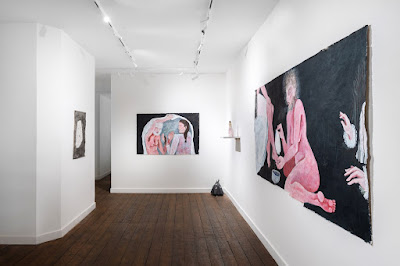Carrie Bencardino at PIEDRAS Galeria, Buenos Aires
Given that England is in lockdown at the moment, there are few ways to access art shows, (an idea that would actually be disputed by a recent article I read on ofluxo by Loney Abrams, which outlined how the internet is superseding the gallery space as the primary platform for art viewing) but for me and many others, visiting exhibitions in person is a valued experience. Alas, to minimise excessive screen time I've avoided most virtual shows this time round, which has led me to checking out the fab ArtViewer site to get my exhibition fill. While this would be far from ideal in normal times, I'm embracing the opportunity to check out global gallery networks from the comfort of my living room. While scoping out the site, the work of Argentinian artist Carrie Bencardino at Buenos Aires gallery PIEDRAS really stood out for me. The soft strokes of paint combined with the visually dark palette and gothic tropes produce a highly personal body of work which resonates with many of us, with its refusal to portray a one-dimensional character profile. 'Never gonna forget how awful I felt' (which translates to 'Nunca voy a olvidar lo mal que la pasé') is a collection of fifty paintings by Bencardino made between 2017 and 2020. The show closed in its physical form on 14 November 2020, but in documentation form it lives on, and it is from this vista that I write.
The paintings we encounter at PIEDRAS are suitably nightmarish for the 2020 time capsule, but have a strong quality that touches upon memories; having these thoughts while in lockdown makes me think about how reliable our treasured memories really are. I remember a quote from the season finale of The Office US, where infuriating posh-boy-gone-wrong Andy Bernard says "I wish there was a way to know you were in the good old days before you actually left them". While this is undeniably corny, in a year where most of us have made very few happy memories, we look to nostalgia and their visual matter, the evidence, their residues, physical remembrances of the people we were and traces of the people, and environments, we love(d).
PIEDRAS' exhibition has been curated in different styles within the space, with one vast black wall and a parallel wall filled with paintings, resembling a sketchbook or a bedroom wall. Bencardino is inspired by various subcultures and scenes that have inspired her life, and during this moment of isolation it is nice to gain insight into other experiences. Sweeping brushstrokes feel highly traditional, yet the subject matter feels not only personal but almost transcending time and geography; some of the memories depicted here could be from my night out in Camden, or yours in Caballito. The faces are sharp and often standoffish, in contrast with the softness of the applied paint; a melting aesthetic that blurs the memories further and is reminiscent of drug-fuelled nights, belonging to everyone and no one, details hazy. However, the clarity of those we pride ourselves on remembering are highly site-specific: the back of the cab, the queue for the bar, the candlelit living room of the girl you've had a crush on for months. Somehow, Bencardino's work reaches both qualities of transcendence and site-specificity.
Elsewhere in a group, or larger scale, exhibition, such a vast number of works in a relatively small, enclosed space may be overwhelming, yet Bencardino's work is so vibrant and bold that you feel yourself wanting to explore each piece individually, such as an ambiguous, yellow background with a Maleficent figure bearing her gloved hands, and two Munch-like women with fleshy horns and amphibian-like tongues, obscuring boundaries between body and background using the artist's distinctive style. According to the show's press release, Bencardino is inspired by "the trash images of the internet", which makes sense given the number of works in the show, mirroring how many images we are exposed to on a daily basis, but with this we are enveloped in the works and get a thorough understanding of the artist's thought processes.
The aesthetic of queer and other subcultures is adopted and depicted in a way that is thoughtful and illustrated, rather than merely replicated. One figure with blue hair and a spiky leather collar has a cigarette in their mouth, and we see the background swirl with greys and blacks in exactly the same tones as the subject matter's clothes. Contemplating each piece, you can't help but dream of how Bencardino might paint your portrait; grasping individual personalities and aesthetics is a magical visual experience. 'Never gonna forget how awful I felt' comes at a time where these lost moments of chaos and disruption mean something very different to that which we are currently experiencing. Not only does nostalgia at this moment help us reflect on what we're missing, it enables looking forward to ways in which we will live our authentic lives again. Bencardino's grants us access to both the glamorous and gritty moments of the artist's social life, all blurred into a collection of hazy memories in this bright Buenos Aires gallery space.





